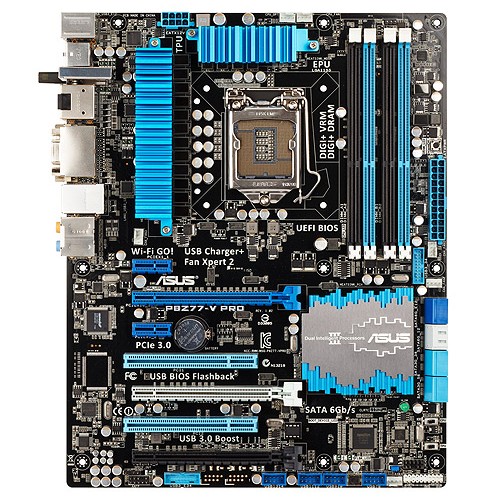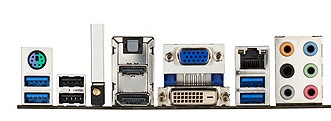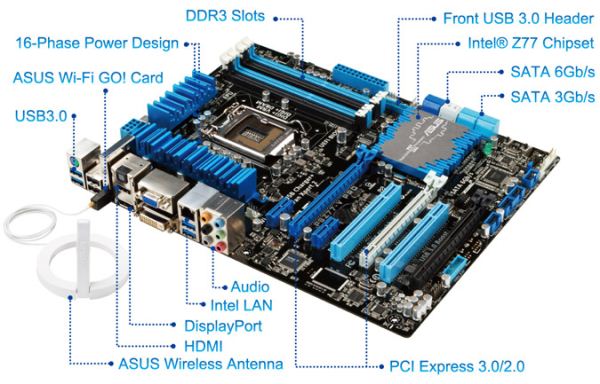Intel Z77 Panther Point Chipset and Motherboard Preview – ASRock, ASUS, Gigabyte, MSI, ECS and Biostar
by Ian Cutress on April 8, 2012 12:00 AM EST- Posted in
- Motherboards
- Intel
- Biostar
- MSI
- Gigabyte
- ASRock
- Asus
- Ivy Bridge
- ECS
- Z77
ASUS P8Z77-V Pro—Visual Inspection
ASUS have a lot to live up to with its Ivy Bridge Pro board. Both the ASUS P8P67 Pro and ASUS P8Z68-V Pro have been top class sellers in their respective chipsets, meaning that ASUS has to deliver. Thankfully, by just looking at the board, it seems that ASUS is keen to innovate and offer a complete package.
Using a 12 + 4 VRM power delivery system, the ASUS P8Z77-V Pro sports a blue and black livery synonymous with their channel / non-ROG products. The VRM heatsinks cover a lot of surface area in their jagged fashion, and around the socket itself, we have access to five main fan headers. Two of these are CPU 4-pin headers just north of the top VRM heatsink, one 4-pin below the left hand side VRM heatsink, and two 4-pin headers below the 24-pin ATX power connector, along with a USB 3.0 port. A sixth fan header (4-pin) is found on the south side of the board.

Above the 24-pin ATX power connector, we find the ASUS MemOK! button, which allows memory recovery to default speeds. Along with the ASRock boards, we have eight SATA ports—four SATA 3 Gbps from the PCH and four SATA 6 Gbps—two from the PCH and two more from an ASMedia controller. Below this are the TPU and EPU switches, designed for enhanced CPU performance and energy saving modes respectively.

Along the bottom of the board is the standard array of a front panel audio header, another USB 3.0 header, USB 2.0 headers, and a front panel header. In terms of PCIe layout, despite there being three full-length PCIe connectors on board, we are only limited to using two for multi-GPU setups. In order, we have a PCIe x1, a PCIe 3.0 x16 (x8 in dual GPU), x1, PCI, PCIe 3.0 x8, PCI, and a PCIe 2.0 x4. Thus in dual GPU mode, similarly to the ASRock Extreme6, we can also add in a PCIe x1 and PCIe x4 card.
The chipset heatsink is indicative of the large but low philosophy of many motherboard manufacturers, hiding away the chipset controller. What is not on these boards, as you may notice, is a combination power/reset pair of buttons, nor a two-digit debug, some of which we used to see on ASUS Pro boards of old. Nevertheless, the ASUS board in return makes up for it on the back IO panel.

On the back panel, we have a combination PS/2 port, two USB 3.0 ports (blue), two USB 2.0 ports (black), an ASUS Wi-Fi GO! Card, optical SPDIF output, HDMI, DisplayPort, D-Sub, DVI-D, gigabit Ethernet, two more USB 3.0 ports in blue, and standard audio headers.
This means that rather than add in a WiFi module on the board, or use up a mini-PCIe slot with wifi, we have a slot in order to add a WiFi module. This can be in 2.4 GHz or 5 GHz mode, and updateable as WiFi standards change. This all comes as part of the package, with magnetic wireless antenna to attach to the case.
Board Features
| ASUS P8Z77-V Pro | |
| Size | ATX |
| CPU Interface | LGA-1155 |
| Chipset | Intel Z77 |
| Power Delivery | 12 + 4 |
| Memory Slots |
Four DDR3 DIMM slots supporting up to 32 GB Up to Dual Channel |
| Video Outputs | DisplayPort, HDMI 1.4a, DVI-D, D-Sub |
| Onboard LAN | Intel 82579V |
| Onboard Audio | Realtek ALC892 |
| Expansion Slots |
2 x PCIe x16 Gen3 (x16, x8/8) 1 x PCIe x16 Gen2 (x4) 2 x PCIe x1 Gen2 2 x PCI |
| Onboard SATA/RAID |
2 x SATA 6 Gbps (PCH), Support for RAID 0, 1, 5, 10 2 x SATA 6 Gbps (ASMedia) 4 x SATA 3 Gbps (PCH), Support for RAID 0, 1, 5, 10 |
| USB |
Four USB 3.0 at rear (2 PCH, 2 ASMedia) Two USB 3.0 headers on board (PCH, ASMedia) Ten USB 2.0 (2 back panel, 8 on board) |
| Onboard |
4 x SATA 6 Gbps 4 x SATA 3 Gbps 2 x USB 3.0 Headers 4 x USB 2.0 Headers 6 x Fan Headers 1 x SPDIF Header 1 x Front Panel Audio Header MemOK! Button TPU/EPU Switches USB Flashback Button |
| Power Connectors |
1 x 24-pin ATX connector 1 x 8-pin 12V connector |
| Fan Headers |
1 x CPU Fan Header (4-pin) 4 x CHA Fan Headers 1 x OPT Fan Header |
| IO Panel |
1 x PS/2 Combo Port 1 x DisplayPort 1 x HDMI 1.4a 1 x DVI-D 1 x D-Sub 1 x Gigabit Ethernet 4 x USB 3.0 2 x USB 2.0 1 x Optical SPDIF 1 x WLAN Connector 6 x Audio Jacks |
| Warranty Period | 3 Years |
| Product Page | Link |
ASUS as a direct standard are now placing Intel NICs on all their channel motherboards. This is a result of a significant number of their user base requesting them over the Realtek solutions. Also to note are a total of six USB 3.0 on board, two on the back panel and four from internal headers. These USB 3.0 ports can take advantage of the improved UASP USB 3.0 protocol using appropriate hardware and some ASUS software. As always, we expect ASUS fan control of the six headers to be top notch.











145 Comments
View All Comments
Iketh - Sunday, April 8, 2012 - link
"handling input in a game engine" means nothing here. What matters is when your input is reflected in a rendered image and displayed on your monitor. That involves the entire package. Lucid basically prevents GPUs from rendering an image that won't get displayed in its entirety, allowing the GPU to begin work on the next image, effectively narrowing the gap from your input to the screen.extide - Tuesday, April 10, 2012 - link
I am sure he knows that. He was just giving a bit of detail as to his exact experience, of which I would bet is far more than most people on here. You have to be very aware of things such as latency and delay when you are handling input in a game engine. I agree with the OP and am skeptical also. The bit that makes me most curious is the transfer of the fully rendered screens from one framebuffer to the other, that has to add some latency, and probably enough to make the entire process worthless. It's not like Lucid has a good track record on stuff like this, I mean we all know how their cross platform SLI/CF took off and worked so well....Iketh - Wednesday, April 11, 2012 - link
Why would you need to physically copy framebuffers?? I'm sure pointers are used...I have no idea if this has tangible benefits, but theoretically it does. None of us know until we can test it. I'm more inclined to discredit the people already discrediting Lucid, despite Lucid's track record. That's what you call hating.
Iketh - Wednesday, April 11, 2012 - link
excuse me, you're right... it has to copy the frame from gpu to igpu... what kind of crap tech is this???ssj3gohan - Sunday, April 8, 2012 - link
Personally, I'm absolutely uninterested in anything 'high-performance', especially fancy gaming stuff. Not to say that I don't think that's a valid market niche, but I see other possibilities.I'm really looking forward to new thin ITX boards with built-in DC-DC converter (i.e. running directly off a 19V brick), and I am especially wondering whether Intel (or Zotac, possibly) is going to build a golden board this time around. Last time, they made DH61AG which was a nice board, but lacked an msata port (kind of a must for a truly thin computer) and 'only' had an H61 chipset.
With H77, I expect it will be possible to make a thin ITX board with USB 3.0 and a fast on-board SSD option, combining this with an HD 4000 equipped processor would enable users to build a truly thin (sub-4 inch thick) computer that fits on the back of their monitor but still provides ample computing power.
Senti - Sunday, April 8, 2012 - link
It sounds to me that Lucid Virtual V-Sync is just glorified triple buffering with a lot of marketing and a bit of overhead for transferring frames and powering two video cards instead of one. I'm very skeptical on the HyperFormance too.Cavalcade - Sunday, April 8, 2012 - link
It seems a bit more involved than triple buffering, more like having 2 buffers where the back buffer is not flipped until it is fully rendered. Seems like this would lead to more stuttering, and given the number of times they asked Mr. Cutress to reiterate that this would be a bug, it may be something they are seriously concerned with.Thinking about it a little more, I'm not sure what advantages this system would have over a system with separated input and rendering modules. The academic side of me is extremely interested and hopeful, but the practical developer side of me is going to require a lot more to be brought on board.
Iketh - Sunday, April 8, 2012 - link
Separate input and rendering modules, as I stated in an earlier post, means nothing. They allow for a responsive mouse cursor, for instance. But, when you actually provide input that alters the RENDERED WORLD, you have to wait for that input to reflect on screen. It doesn't matter how perfectly the software solution is architected, you still have to wait for the rendering of the image after your input.Lucid simply prevents renders that never get displayed in their entirety, allowing the GPU to work on the NEXT image, shortening the time from your input to the screen.
Cavalcade - Monday, April 9, 2012 - link
The comment was to indicate that while I have experience writing input systems, rendering is still relatively new to me; simply a qualifier of my impression and opinion.The way I am understanding Lucid, it is attempting to preempt displaying a frame that is not fully rendered in time for the next screen refresh. By presenting a virtual interface to both the GPU and the application, the application believes the frame has been rendered (displaying user input at that time) and proceeds to render the next frame. Thinking more about it, would this reduce the time interval between input reflected in frame one (which was preempted) and frame two (which will be displayed) so that rather than having input sampled at a fixed rate (say 60Hz) and displayed at a variable rate, input would be more closely tied to the frame for which it is intended.
My interest is rising, but it still seems like a rather complex solution to a problem that I either haven't experienced, or which doesn't really bother me.
Iketh - Tuesday, April 10, 2012 - link
it's not preemtively doing anything, except determining if a frame added to the queue will finish rendering in time... if not, it >>>>DOESNT LET THE GPU RENDER IT<<<< and places the previously rendered image in its place, allowing the GPU to immediately begin work on the FOLLOWING frame... that's it... it cuts unneeded frames from queuesas for your input sampling rate question, that's entirely based on how the application is coded to handle input, lucid has nothing to do with this...